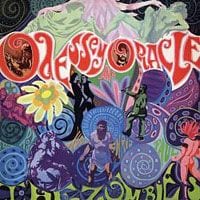
When British pop act the Zombies arrived at Abbey Road Studios in June of 1967, the Beatles had just finished wrapping up the sessions for Sgt. Pepper’s Lonely Hearts Club Band. By April 21st, the Beatles had logged hundreds of hours for their ambitious eighth studio record, although the sessions for Sgt. Pepper’s included dates that yielded non-LP tracks like “Only a Northern Song” and more. When those reportedly agonizing sessions of tape splicing and manual scissor edits adjourned, the Beatles left a number of instruments behind. Among them was a Mellotron, an early 1960s era keyboard that offered sample playback via magnetic audio tape. That summer, the Zombies were eager to incorporate Mellotron sounds in the recording of their sophomore album Odessey & Oracle, a polished, classically-influenced cornerstone of English psychedelic pop. The band split before Odessey saw release, much less before its single “Time of the Season” garnered number-one chart status in 1969.
During an endlessly fascinating new BBC “Mastertapes” interview with Zombies members Colin Blunstone, Chris White, and Rod Argent, presenter John Wilson pressed the band about their experiences at Abbey Road Studios. The artists were eager to chat about the access to multi-tracking they had at Abbey Road, and how they benefited from the ability to layer harmonies or piano leads on top of their sparse backing tracks. At the onset of the discussion, Argent talked about how the Beatles had made use of multi-tracking for Sgt. Pepper’s, and that while the engineers were making it available to the Zombies, studio personnel confirmed that mixing multiple tracks down to single tracks and bouncing them between two four-track tape machines to make room for overdubs “was a nightmare”.
“That was the excitement of producing the album ourselves”, said Rod Argent in an interview for the liner notes of 1997’s Zombie Heaven, the Zombies box set from Big Beat Records. “If we wanted to do a mass vocal thing like we did on ‘Changes’, with all the harmony lines equal, we could because we were doing it ourselves. We were very ‘up’ about all that.”
During the BBC interview, there’s a brief discussion of the Zombies’ baroque era influences. Rod Argent demonstrated where Bach had figured in by way of a live piano rendition of the classically driven bridge section of Odessey‘s “Hung Up on a Dream”, a song which prominently features the Mellotron.
“(‘Hung Up’) wasn’t at all about an acid trip”, said Argent during the talks for Zombie Heaven, refuting the speculation that the band members were LSD advocates. “All I remember about the writing of that song was that we’d just discovered the Mellotron, and that was a bit of an inspiration.”
An Abbey Road session in late 1966 afforded Beatles member Paul McCartney the opportunity to thicken the already dreary chorus segment of bandmate John Lennon’s “Strawberry Fields Forever” with the Mellotron’s “Swinging Flutes” setting. That’s a comparatively minor part of the tale, however. Writer Robert Webb has an excellent account in The Independent of the night “Lennon casually told his recording team that he wanted the two (previously recorded ‘Strawberry Fields’) versions joined together.” The songwriter decided that a heavier version than what they’d previously laid down was needed. According to music journalist and author Paul Du Noyer, John Lennon encountered a “sense of aimlessness” after having returned home from Spain, where the chords for “Strawberry Fields” began to take shape while he was filming How I Won the War. “Shell-shocked by the first four years of Beatlemania”, wrote Du Noyer for Q in 1999, “Lennon had withdrawn into a cocoon of private misery, living in Home Counties isolation amid the slow decay of his marriage to Cynthia.”
When played alongside “Strawberry Fields Forever”, the Zombies’ “Changes” is a particularly upbeat piece of music. Almost exactly a year after the start of the “Strawberry Fields” sessions, Rod Argent was sitting where Lennon sat. He was tracking a section of Mellotron that would bookend “Changes”, a strikingly innovative three minutes of Odessey & Oracle that features little more than the newfangled keyboard’s swirls, piano, and the whole band’s dense layer of vocal harmonies. Rich with bassist Chris White’s storybook-like characterization of an affluent woman who’d traded her simple life for one of “diamonds and stones”, “Changes” is balanced by percussive hand drums and an airy melody.
Argent unpacked the Mellotron’s place in “Changes” during the new BBC interview. “I thought of it, first of all, as orchestra substitute, but of course it’s got totally its own sound”, said Argent to John Wilson. The Mellotron allowed for playback of up to approximately eight-second intervals of sampled violins, flutes, and more. “I think that (on) a lot of the album, a lot of the songs were about color. In something like ‘Changes’, we were aware of color all the way through. So we would start with Mellotron.”
Listen to the Zombies BBC “Mastertapes” interview here or download both episodes.

![Call for Papers: All Things Reconsidered [MUSIC] May-August 2024](https://www.popmatters.com/wp-content/uploads/2024/04/all-things-reconsidered-call-music-may-2024-720x380.jpg)



